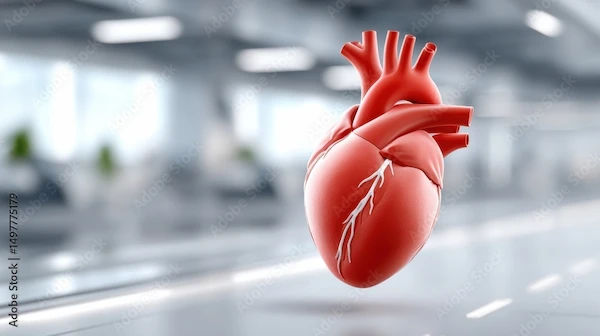Different Types of Heart Disease
Explore various types of heart conditions, including coronary artery disease, arrhythmias, heart failure, and valve disorders. Understanding symptoms and risk factors can help in early detection, prevention, and effective management for better heart health.

Written by Dr Sonia Bhatt
Last updated on 3rd Jul, 2025
Heart disease refers to a range of conditions that impact the heart’s structure or function. When the heart is not functioning properly, it struggles to supply sufficient oxygen, blood, and nutrients to the body, which can interfere with the normal functioning of various bodily systems. The good news is that many forms of heart disease can be prevented or managed through healthy lifestyle choices. Continue reading to explore the different types of heart disease and their symptoms.
Coronary Artery Disease (CAD)
CAD occurs when the coronary arteries, which provide oxygen-rich blood to the heart, become narrowed or blocked. This narrowing happens due to plaque buildup over time, consisting of cholesterol and other substances, which restricts blood flow to the heart muscle. Often, CAD remains unnoticed until a blood clot forms, triggered by the plaque, cutting off blood flow and resulting in a heart attack. Many people may live with CAD for years without symptoms until such an event occurs. CAD can present in two primary forms:
- Stable Ischemic Heart Disease: This chronic condition develops gradually as the coronary arteries narrow over time.
- Acute Coronary Syndrome: A sudden and life-threatening condition where plaque ruptures in a coronary artery, leading to a blood clot that blocks blood flow and causes a heart attack.
Heart Arrhythmias
An arrhythmia refers to an irregular heartbeat. Normally, the heart beats in a well-coordinated and organised manner. However, disruptions in various parts of the heart or even in the blood it pumps can interfere with its normal rhythm, leading to arrhythmias. While some arrhythmias are harmless and don’t require intervention, others can pose serious risks, such as cardiac arrest. Arrhythmias are classified based on their origin within the heart:
- Supraventricular Arrhythmias: These originate in the atria, the upper chambers of the heart. The term "supraventricular" means above the ventricles, or lower chambers.
- Ventricular Arrhythmias: These start in the heart’s ventricles, the lower chambers responsible for pumping blood.
- Bradyarrhythmias and Junctional Rhythms: These result from issues within the heart’s electrical conduction system, such as the atrioventricular (AV) node, sinoatrial (SA) node, or the His-Purkinje network.
Common symptoms of heart arrhythmias include:
- Dizziness or lightheadedness
- Heart palpitations
- Fainting spells
- Chest discomfort
- Shortness of breath
- Generalised weakness or fatigue
Heart Failure
Heart failure is a chronic condition where the heart cannot pump blood effectively enough to meet the body’s requirements. Although the heart continues to function, its reduced capacity leads to blood accumulating in other parts of the body, commonly in the lungs, feet, and legs. This results in various symptoms, including:
- Shortness of breath, especially during activity or at night
- Waking up gasping for air
- Fatigue during physical activity
- Chest discomfort or heart palpitations
- Swelling in the legs, ankles, and abdomen
- Frequent urination at night
- Rapid weight gain
- A persistent dry cough
- Nausea or loss of appetite
- A bloated or hard stomach
Several factors can lead to congestive heart failure, including:
- Cardiomyopathy, whether genetic or caused by viral infections
- Coronary artery disease or previous heart attacks
- Congenital heart defects
- Arrhythmias
- Chronic conditions such as diabetes and hypertension
- Kidney disease
- Lifestyle factors like alcohol, smoking, and recreational drug use
- Obesity, with a BMI over 30
- Certain medications, such as those used in cancer treatments like chemotherapy
Heart Valve Disease
Heart valve disease encompasses various conditions that impair the proper functioning of one or more heart valves. The most common types include:
- Valvular Stenosis: This occurs when the valve tissues become rigid, narrowing the valve opening and limiting blood flow.
- Valvular Insufficiency: Also known as regurgitation, this happens when blood leaks backward through the valve, forcing the heart to work harder to compensate for the loss.
- Valvular Atresia: A congenital condition where a heart valve doesn’t form properly before birth.
As the condition progresses, symptoms may develop, such as:
- Irregular heartbeats or palpitations
- Shortness of breath, particularly during activity or when lying down
- Swelling in the feet, ankles, or abdomen (edema)
- Rapid weight gain
- Fatigue, dizziness, or weakness
- Fever, body aches, or chills if infection is the underlying cause
- Chest discomfort, especially during exertion
Congenital Heart Defects
Congenital heart disease (CHD) refers to structural abnormalities in the heart that are present from birth. These defects can disrupt normal blood flow and may involve:
- Heart Wall Defects: Such as a hole in the heart's wall.
- Blood Vessel Irregularities: Issues like having too few or too many vessels, blood flowing too slowly, in the wrong direction, or to the wrong location.
- Valve Problems: Malfunctions in the heart valves that regulate blood flow.
While some cases are mild and asymptomatic, severe forms may be life-threatening and require early medical intervention. Symptoms of CHD can appear at birth or develop later in life, including:
- Unusual fatigue or sleepiness
- Bluish lips, skin, or nails (cyanosis)
- Extreme tiredness, particularly during physical activity
- Rapid or difficult breathing
- Poor circulation or weak pulses
- Abnormal heart sounds, such as murmurs
Cardiomyopathy
Cardiomyopathy is a condition that impacts the myocardium, or heart muscle, leading to changes such as thickening, stiffening, enlargement, or the development of scar tissue. These changes impair the heart's ability to effectively pump blood to the body, and over time, can result in heart failure. Symptoms of cardiomyopathy may include:
- Irregular or rapid heartbeats (palpitations)
- Fatigue
- Chest discomfort.
- Shortness of breath (dyspnea)
- Arrhythmias
- Fainting episodes (syncope)
- Swelling in the ankles or legs (edema)
While some individuals may remain asymptomatic and not require treatment, others may develop noticeable symptoms as the condition progresses, necessitating medical intervention.
Peripheral Artery Disease (PAD)
Peripheral artery disease (PAD) occurs when plaque accumulates in the arteries that supply blood to your legs. These arteries transport oxygen- and nutrient-rich blood from the heart to your limbs. Over time, this plaque—composed of cholesterol, fat, and other substances—builds up along the artery walls, narrowing them in a condition known as atherosclerosis. In some cases, blood clots form around the plaque, further restricting blood flow.
When the arteries become significantly narrowed or blocked, blood cannot adequately reach tissues, leading to damage or even tissue death (gangrene), particularly in the toes and feet. The most common symptom of PAD is pain in the legs that arises during physical activity and subsides with rest. This pain results from insufficient oxygen reaching the leg muscles. PAD can also cause non-healing sores on the legs or feet. In severe cases, these sores may progress to gangrene, which can necessitate the amputation of the affected limb.
Risk Factors for Heart Disease
Certain factors increase your likelihood of developing heart disease. These risk factors include:
- High blood pressure (hypertension)
- Elevated cholesterol levels
- Use of tobacco products
- A family history of heart disease
- A sedentary lifestyle
- A body mass index (BMI) above 25, indicating overweight
- Type 2 diabetes
- Substance use disorders
- Consuming an unhealthy diet
Conclusion
Heart disease encompasses a wide spectrum of conditions that affect the heart’s structure and function, each presenting unique challenges and symptoms. While some types of heart disease may develop gradually without noticeable symptoms, others can emerge suddenly and pose life-threatening risks. Understanding the causes, symptoms, and risk factors associated with heart disease is essential for early detection and management.
Maintaining a heart-healthy lifestyle, which includes a balanced diet, regular exercise, avoiding tobacco, and managing stress, can considerably reduce the risk of heart disease. For those already affected, timely medical intervention and adherence to treatment plans can improve outcomes and quality of life.
Consult Top Cardiologists
Consult Top Cardiologists

Dr. Sumanjita Bora
Cardiologist
9 Years • MBBS, PGDCC
Bengaluru
Apollo Clinic, Sarjapur Road, Bengaluru

Dr. Bhethala Sharan Prakash
General Physician/ Internal Medicine Specialist
5 Years • MBBS MD
Bengaluru
PRESTIGE SHANTHINIKETAN - SOCIETY CLINIC, Bengaluru

Dr. Dayanashre N
General Physician
3 Years • MBBS
Bengaluru
PRESTIGE SHANTHINIKETAN - SOCIETY CLINIC, Bengaluru

Dr. Anand Ravi
General Physician
2 Years • MBBS
Bengaluru
PRESTIGE SHANTHINIKETAN - SOCIETY CLINIC, Bengaluru

Dr. Vignesh Thanikgaivasan
Cardiologist
11 Years • MBBS, MD (Gen Med), DM (Cardiology) AFAPSIC, FIMSA, FSCAI
Chennai
Apollo Hospitals Greams Road, Chennai
(75+ Patients)


